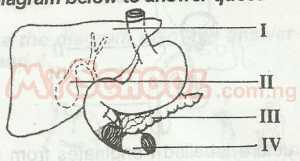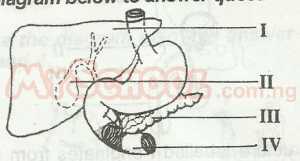Year :
2005
Title :
Biology
Exam :
JAMB Exam
Paper 1 | Objectives
11 - 20 of 50 Questions
| # | Question | Ans |
|---|---|---|
| 11. |
The blackfly is a vector of A. malaria B. trypanosomiasis C. onchocerciasis D. yellow fever |
C |
| 12. |
The transition from amphibians to mammals involves the limb becoming arranged to support the weight more effectively requiring modifications in the A. collar bones and coccyx B. pectoral and pelvic girdles C. scapulae and clavicles D. vertebrae and sternum |
B |
| 13. |
The main function of the caudal fin in Tilapia is to A. propel it forward in water B. steer it while changing direction C. balance it in water D. enable it to float in water |
A |
| 14. |
In the root vascular system, the stele is directly surrounded by the A. pericycle B. cortex C. endodermis D. parenchyma |
A |
| 15. |
 From the diagram above the part labelled IV represents the A. colon B. ileum C. caecum D. duodenum |
D |
| 16. |
 From the diagram above, The bile is stored in the part labelled A. I B. II C. III D. IV |
B |
| 17. |
The only vein that carriers pure oxygenated blood is the A. renal vein B. pulmonary vein C. hepatic vein D. sciatic vein |
B |
| 18. |
The function of the fluid - filled pericadium is to A. reduce the friction caused by the pumping movements of the heart B. supply the heart with organisms from attacking the heart C. prevent disease organism from attacking the heart D. reduce the intensity of the pumping |
A |
| 19. |
The mammalian lung is made air tight by the A. pleural cavity B. mucous membrane C. pleural membrane D. diaphragm |
C |
| 20. |
A test tube containing yeast in glucose solution containing alkaline pyrogallol. The bubbles of carbon (IV) oxide produced indicates that the yeast cells are A. respiring in the absence of oxygen B. liberating oxygen on their own C. living and consuming oxygen D. being killed by the alcohol produced |
A |
| 11. |
The blackfly is a vector of A. malaria B. trypanosomiasis C. onchocerciasis D. yellow fever |
C |
| 12. |
The transition from amphibians to mammals involves the limb becoming arranged to support the weight more effectively requiring modifications in the A. collar bones and coccyx B. pectoral and pelvic girdles C. scapulae and clavicles D. vertebrae and sternum |
B |
| 13. |
The main function of the caudal fin in Tilapia is to A. propel it forward in water B. steer it while changing direction C. balance it in water D. enable it to float in water |
A |
| 14. |
In the root vascular system, the stele is directly surrounded by the A. pericycle B. cortex C. endodermis D. parenchyma |
A |
| 15. |
 From the diagram above the part labelled IV represents the A. colon B. ileum C. caecum D. duodenum |
D |
| 16. |
 From the diagram above, The bile is stored in the part labelled A. I B. II C. III D. IV |
B |
| 17. |
The only vein that carriers pure oxygenated blood is the A. renal vein B. pulmonary vein C. hepatic vein D. sciatic vein |
B |
| 18. |
The function of the fluid - filled pericadium is to A. reduce the friction caused by the pumping movements of the heart B. supply the heart with organisms from attacking the heart C. prevent disease organism from attacking the heart D. reduce the intensity of the pumping |
A |
| 19. |
The mammalian lung is made air tight by the A. pleural cavity B. mucous membrane C. pleural membrane D. diaphragm |
C |
| 20. |
A test tube containing yeast in glucose solution containing alkaline pyrogallol. The bubbles of carbon (IV) oxide produced indicates that the yeast cells are A. respiring in the absence of oxygen B. liberating oxygen on their own C. living and consuming oxygen D. being killed by the alcohol produced |
A |